Personal Details
Born: 7 September 1881 in Holywell, Flintshire and baptised with his twin sister Alice on 9 September 1881 at Pontblyddyn Parish Church, Flintshire.
Family: He was one of seven children born to John Charles Knight, a butler, and his wife Mary. He married Edith E Baker in 1916 in Whitchurch, Shropshire. The couple do not appear to have had any children.
Residence: In 1891 Albert`s family were living at Boden Cottage, Old Rode, Congleton, Cheshire. Some ten years later they can be found at The Cambrian Hotel, Abergele, Flintshire. By 1911 Albert was a boarder at Glendale House, 34 Talbot Street, Whitchurch, Shropshire. In 1919 and now married, he and his wife were living at 23 Worthington Street, Whitchurch. He remained at this address for the rest of his life.
Employment: In 1911 his occupation was described as a bookstall clerk and on his military records as a newsagent. By 1939 he was a porter at the Public Assistance Institute.
Died: In 1967 at Deermoss Hospital, Whitchurch, Shropshire and was buried 28 June the same year in Whitchurch cemetery, aged 85.
Military Details
Regiment: Royal Garrison Artillery (previously Shropshire Yeomanry and King’s Shropshire Light Infantry)
Rank: Private
Service Number: 314874 (previously 16947 and 205069)
Date of Enlistment: 18 August 1915
Date of Discharge: 26 March 1920
Reason for Discharge: Disembodied
Albert was awarded the Campaign Medals (British War Medal, and Victory Medal)

The British War Medal (also known as 'Squeak') was a silver or bronze medal awarded to officers and men of the British and Imperial Forces who either entered a theatre of war or entered service overseas between 5th August 1914 and 11th November 1918 inclusive. This was later extended to services in Russia, Siberia and some other areas in 1919 and 1920. Approximately 6.5 million British War Medals were issued. Approximately 6.4 million of these were the silver versions of this medal. Around 110,000 of a bronze version were issued mainly to Chinese, Maltese and Indian Labour Corps. The front (obv or obverse) of the medal depicts the head of George V. The recipient's service number, rank, name and unit was impressed on the rim.
The Allied Victory Medal (also known as 'Wilfred') was issued by each of the allies. It was decided that each of the allies should each issue their own bronze victory medal with a similar design, similar equivalent wording and identical ribbon. The British medal was designed by W. McMillan. The front depicts a winged classical figure representing victory. Approximately 5.7 million victory medals were issued. Interestingly, eligibility for this medal was more restrictive and not everyone who received the British War Medal ('Squeak') also received the Victory Medal ('Wilfred'). However, in general, all recipients of 'Wilfred' also received 'Squeak' and all recipients of The 1914 Star or The 1914/1915 Star (also known as 'Pip') also received both 'Squeak' and 'Wilfred'. The recipient's service number, rank, name and unit was impressed on the rim.

